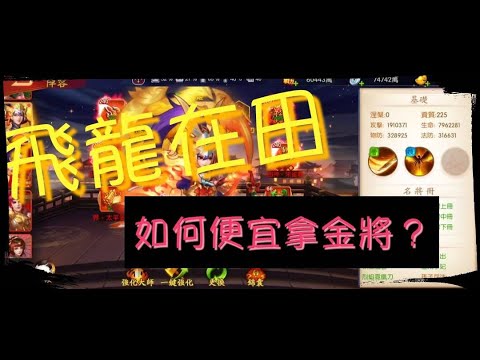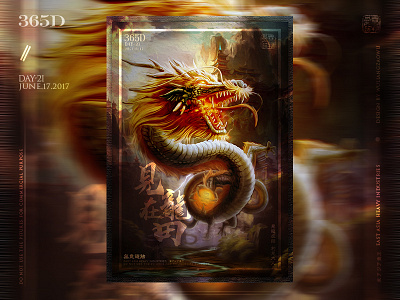見龍在田: 靈感探索與自由想像
【招財貓】👑三國殺名將傳 📢 見龍在田!如何便宜拿金將與金將說明(教學📝)
用戶搜尋的關鍵字: 見 龍 在 田 見龍在田飛龍在天, 潛龍勿用見龍在田飛龍在天亢龍有悔, 見龍在田利見大人, 見龍在田易經, 見龍在田利見大人意思, 見龍在田德施普也, 見龍在天, 降龍十八掌
見龍在田:深度解析龍的文化象徵與歷史根源
歷史背景與起源
「見龍在田」一詞源自中國古代文化,有著深厚的歷史背景與起源。這個詞語的形成牽涉到中國古代的哲學思想、卜卦術和對自然的敬畏。最早可以在《易經》中找到「見龍在田」的相關記載,這使得它成為中國傳統文化中的一個重要元素。
《易經》中的意義
《易經》是中國古代典籍之一,其中「見龍在田」承載著深刻的象徵意義。在卜卦的過程中,龍常常被視為吉祥的象徵,而田地則代表了自然的一部分。當卜卦中出現「見龍在田」的情境時,這往往被解讀為一種吉兆,預示著好運和豐收。
這一詞語還在《易經》的哲學思想中佔據著重要的位置。龍被視為一種神秘的存在,與天地自然相連結。在哲學層面上,「見龍在田」意味著人們應該保持與自然的和諧,順應天道,以求得事事順利。
龍的文化象徵與意義
龍在中國文化中一直具有極高的地位,被視為祥瑞和權力的象徵。「見龍在田」中的龍,不僅是一種生物,更是一種文化的象徵。它代表著權力、威嚴和祥瑞,常常與帝王、皇室聯繫在一起。
在歷史、宗教和藝術中,龍的形象經常出現,凸顯了它在中國文化中的重要性。帝王常以龍為象徵,認為自己具有龍的血統,這種觀念在中國古代社會深深植根。
田地與自然元素的關聯
「在田」的象徵意義中,田地和自然元素扮演著重要的角色。田地代表了土地,是農業社會中人們生活的基石。而龍的出現,則使得這片土地更加神聖和富饒。這種聯繫突顯了人們對自然的敬畏,以及對農業豐收的期待。
在「見龍在田」的觀念中,人與自然的和諧相處被強調,提醒人們要與自然共生,保護環境,追求永續發展。這種觀念在古代就已經存在,今天仍然具有重要的現實意義。
龍的形象在文學與藝術中的呈現
龍的形象在中國文學、繪畫和其他藝術形式中有著豐富的表現。在文學作品中,龍常常被描繪成神秘、威武的存在,具有強大的力量。在繪畫中,龍的形象經常與自然景觀相結合,形成獨特的藝術風格。
這些呈現不僅展現了藝術家對龍的崇敬,也反映了「見龍在田」的文化影響。龍被視為與自然環境融合的存在,這種觀念在藝術中得到了生動的表現。
地區差異與變異
儘管「見龍在田」這一觀念在整個中國文化中有著相似的基礎,但在不同地區仍然存在一些差異和變異。這些差異可以從區域性的信仰、傳統和習俗中找到。
一些地區可能對「見龍在田」的解讀有所不同,甚至可能賦予它們獨特的文化意義。這種地域性的差異使得「見龍在田」在不同區域間呈現出豐富多樣的面貌,這也反映了中國文化的多元性和區域性。
現代應用與解讀
在現代社會中,「見龍在田」這一觀念仍然有著廣泛的應用。除了在傳統文化和藝術中的表現外,它還在各種現代活動中扮演著重要角色。例如,有些企業可能在開業儀式上使用這一符號,以求生意興隆、發展順利。
人們對「見龍在田」的現代解讀也更加多元。一些人可能將其視為一種祈福的方式,期待好運和成功;而另一些人可能將其理解為與自然環境和諧相處的象徵,提倡環保和可持續發展。
見龍在田飛龍在天
在「見龍在田」的相關詞語中,「見龍在田飛龍在天」更是引人注目。這一表述強調了龍的飛翔,象徵著更高的抱負和追求。這同時也提醒人們要志存高遠,不斷追求進步,勇攀事業的巔峰。
潛龍勿用見龍在田飛龍在天亢龍有悔
這一語句強調了龍的潛力,警示人們在某些情況下不宜過於強勢。潛龍勿用,提醒人們在某些情勢下要保持低調,不要過於張揚,以免引來後悔。
見龍在田利見大人
這一古語強調了「見龍在田」的好兆頭,特別是對於領袖和權威人物。見到龍在田地中,預示著大人物的到來,可能是一個有利的時機,需要善加利用。
見龍在田易經
「見龍在田」在易經中的解讀更是值得深入探討。易經作為中國古代的經典之一,對於人類命運和自然法則有著獨特的見解。在易經中,「見龍在田」的出現可能代表著一種機遇或者良好的發展方向,這需要藉由卜卦等方式進一步解讀。
見龍在田利見大人意思
這一詞語的意思強調了「見龍在田」所帶來的好處,尤其是對於具有權威地位的人物。見到龍在田地中,預示著大人物的到來,可能是一個具有深遠意義的時刻。
見龍在田德施普也
這一句話中的「德施普也」強調了在「見龍在田」的時刻中應該表現出良好的品德。這提醒人們,在獲得好運的同時,也應該以正直、慈悲的心態對待他人,以求得更長遠的幸福。
見龍在天,降龍十八掌
這一詞語中的「降龍十八掌」可能是受到武俠小說或影視作品的影響,強調了在見到龍在天的情境中,需要具備強大的力量和技能。這同時也可能象徵著在艱難困境中挑戰強大敵人的勇氣。
FAQ
1. 見龍在田的起源是什麼時候?
「見龍在田」一詞的起源可以追溯到中國古代,《易經》是其中最早出現的文獻之一,約在公元前9世紀左右。
2. 「見龍在田」在卜卦中有何意義?
在卜卦中,「見龍在田」被視為吉祥的象徵,預示著好運和豐收的來臨。
3. 龍在中國文化中有哪些象徵意義?
龍在中國文化中象徵著權力、祥瑞和吉祥,常與帝王、皇室聯繫在一起。
4. 現代社會中「見龍在田」有哪些應用?
「見龍在田」在現代社會中常用於開業儀式等場合,代表著好運和事業發展的順利。
5. 為什麼在不同地區對「見龍在田」的理解有差異?
差異可能來自地區性的信仰、傳統和習俗,使得在不同區域間呈現出多樣性。
6. 怎麼解讀「見龍在田飛龍在天」這一詞語?
這一表述強調了龍的飛翔,象徵著更高的抱負和追求,提醒人們要志存高遠。
7. 「降龍十八掌」和「見龍在天」有什麼關聯?
這可能是武俠小說或影視作品中的表達,強調在見到龍在天的情境中,需要具備強大的力量和技能。
透過深入的探討,我們更能夠理解「見龍在田」的文化意涵以及其在中國傳統文化中的深遠影響。這一詞語不僅代表著對自然和祥瑞的崇敬,也承載著人們對於良好未來的期許與追求。
類別: 分享 13 見 龍 在 田

見龍在田飛龍在天
見龍在田飛龍在天: Exploring the Depths of an Ancient Chinese Saying
In the rich tapestry of Chinese culture and philosophy, there exists a saying that has transcended time and space, resonating through generations – 見龍在田飛龍在天. This enigmatic phrase holds deep meaning and has been woven into the fabric of Chinese thought, offering insights into the complexities of life, nature, and the human experience.
Unraveling the Meaning
Origins and Historical Significance
The saying 見龍在田飛龍在天 has its roots in ancient Chinese literature, particularly in classical texts like the Yijing (易經), also known as the Book of Changes. This venerable work, dating back over two millennia, serves as a foundational text in Chinese philosophy, exploring the dynamic interplay of Yin and Yang, the Five Elements, and the ebb and flow of life.
Literal Translation and Symbolism
Literally translated, 見龍在田飛龍在天 can be understood as “seeing a dragon in the field, a flying dragon in the sky.” This picturesque expression encapsulates profound philosophical ideas. The dragon, a symbol of power and auspiciousness in Chinese culture, takes on metaphorical significance in this saying.
In the field, the dragon is seen, suggesting a tangible and immediate presence. This may be interpreted as recognizing opportunities or challenges in the mundane aspects of life. The flying dragon in the sky represents a higher, transcendental perspective, signifying the broader, overarching principles that guide our destinies.
The Philosophical Depth
Interpreting the Yijing
To truly grasp the essence of 見龍在田飛龍在天, one must delve into the Yijing, where the hexagram Qian (乾) holds relevance. This hexagram is associated with the creative force, representing strength, vitality, and the unyielding power of heaven. The saying draws parallels between observing the dragon in the field, symbolizing the manifestation of creative energy in the tangible world, and the soaring dragon in the sky, representing the cosmic forces that govern our existence.
The Dichotomy of Yin and Yang
At its core, 見龍在田飛龍在天 embodies the ancient Chinese philosophy of Yin and Yang. The field, with its earthly associations, reflects the Yin, the receptive and manifested aspect, while the sky represents the Yang, the dynamic and transcendent force. The saying encourages a holistic understanding of life, emphasizing the interconnectedness of the material and the spiritual.
Practical Applications
Navigating Life’s Challenges
In the journey of life, individuals often find themselves confronted with challenges or opportunities. 見龍在田飛龍在天 serves as a guide, urging individuals to perceive the immediate circumstances (the dragon in the field) while maintaining awareness of larger, universal principles (the flying dragon in the sky). This dual perspective equips individuals with a comprehensive outlook, fostering adaptability and resilience.
Decision-Making and Strategy
The strategic implications of this saying are evident in various fields, from business to personal development. By applying the wisdom embedded in 見龍在田飛龍在天, one can make informed decisions, balancing short-term considerations with long-term vision. This nuanced approach mirrors the wisdom found in traditional Chinese strategic thinking, where foresight and adaptability are paramount.
Frequently Asked Questions (FAQ)
1. What is the origin of the saying 見龍在田飛龍在天?
The saying has its roots in ancient Chinese philosophy, particularly in the Yijing or Book of Changes. It draws upon the symbolism of dragons and their representation of creative and cosmic forces.
2. How can one apply the principles of 見龍在田飛龍在天 in daily life?
In practical terms, the saying encourages individuals to maintain a dual perspective – recognizing immediate circumstances while being mindful of broader, universal principles. This can guide decision-making, foster adaptability, and enhance resilience.
3. Is there a specific hexagram in the Yijing associated with 見龍在田飛龍在天?
Yes, the hexagram Qian (乾) is closely associated with the saying. It embodies the creative force, representing the unyielding power of heaven and the dynamic interplay of Yin and Yang.
4. How does 見龍在田飛龍在天 relate to traditional Chinese philosophy?
The saying encapsulates key elements of traditional Chinese philosophy, including the concepts of Yin and Yang, the Five Elements, and the interconnectedness of the material and spiritual realms.
5. Can 見龍在田飛龍在天 be applied in a business context?
Certainly. The saying’s emphasis on dual perspective and strategic thinking makes it applicable in business settings. It can guide decision-makers in balancing short-term goals with a long-term vision, fostering adaptability in dynamic environments.
In conclusion, 見龍在田飛龍在天 is not merely a saying; it is a profound guide to navigating the complexities of life with wisdom and foresight. As we embrace both the dragon in the field and the flying dragon in the sky, we find a harmonious balance between the immediate and the eternal, the tangible and the transcendent. This ancient wisdom continues to resonate, offering timeless insights for those who seek a deeper understanding of the world and their place within it.
潛龍勿用見龍在田飛龍在天亢龍有悔
潛龍勿用見龍在田飛龍在天亢龍有悔: Exploring the Depths of a Proverb
Introduction
In the rich tapestry of Chinese culture and wisdom, proverbs play a significant role in conveying deep insights and guiding principles for a meaningful life. One such proverb that encapsulates profound wisdom is 潛龍勿用見龍在田飛龍在天亢龍有悔. In this article, we will delve into the layers of meaning behind this ancient saying, exploring its origins, dissecting each component, and unraveling the timeless lessons it imparts.
Origins and Context
潛龍勿用見龍在田飛龍在天亢龍有悔 has its roots deeply embedded in Chinese philosophy and the ancient text of the I Ching (易經), also known as the Book of Changes. The I Ching is a foundational text that has guided Chinese thought for centuries, offering insights into the principles of change, balance, and harmony.
This particular proverb draws inspiration from the imagery of dragons, a symbol of power, transformation, and auspicious energy in Chinese culture. The phrase encourages a thoughtful and strategic approach to one’s actions, cautioning against revealing one’s true strength prematurely.
Dissecting the Components
-
潛龍 (Qián Lóng) – Concealed Dragon:
This segment advises the need to conceal one’s capabilities and strengths. Like a dragon hidden beneath the surface of the water, it suggests the importance of keeping one’s true abilities undisclosed until the opportune moment. -
勿用 (Wù Yòng) – Do Not Use:
The usage of “do not use” underscores the idea that power and skills should not be flaunted unnecessarily. Instead, it advocates for a strategic and measured approach, reserving one’s strengths for situations that truly demand them. -
見龍在田 (Jiàn Lóng Zài Tián) – Seeing a Dragon in the Field:
This part paints a vivid picture of a dragon in an open field, symbolizing the idea that true strength becomes apparent when faced with challenges. It cautions against unnecessary displays of power when not confronted by significant obstacles. -
飛龍在天 (Fēi Lóng Zài Tiān) – Flying Dragon in the Sky:
The image of a flying dragon in the sky suggests the idea of reaching new heights and attaining success. This part encourages the idea that real achievements come when one rises above challenges and adversities. -
亢龍有悔 (Kàng Lóng Yǒu Huǐ) – Arrogance Brings Regret:
The concluding segment serves as a warning against arrogance. It implies that a dragon, when overly confident and arrogant, may face regrettable consequences. It emphasizes the importance of humility and self-awareness.
Interpreting the Proverb
潛龍勿用見龍在田飛龍在天亢龍有悔, when translated, means “Conceal the dragon’s strength; do not reveal it until it faces challenges. When challenges arise, let it soar to the sky. Arrogance leads to regret.” This proverb encapsulates a strategic approach to life, urging individuals to navigate challenges with humility, only revealing their true potential when necessary.
In the context of personal development and interpersonal relationships, the proverb underscores the significance of humility, patience, and resilience. It discourages the unnecessary display of prowess but encourages individuals to rise to the occasion when faced with significant challenges.
FAQs
-
What does the image of a dragon symbolize in Chinese culture?
Dragons hold a special place in Chinese culture and are regarded as symbols of power, strength, and good fortune. They are often associated with the emperor and represent auspicious energy. -
How does the proverb relate to the principles of the I Ching?
The I Ching emphasizes the cyclical nature of change and the importance of balance. The proverb aligns with these principles by advocating a strategic and balanced approach to utilizing one’s strengths. -
Can you provide real-life examples of the application of this proverb?
Instances of leaders showcasing humility and resilience in the face of challenges, only revealing their true capabilities when necessary, align with the essence of this proverb. Historical figures and successful individuals often embody these principles. -
Is there a modern interpretation of this ancient proverb?
In contemporary settings, the proverb can be applied to various aspects of life, from career strategies to personal relationships. It encourages individuals to be discerning about when and how they reveal their strengths and talents. -
How can one cultivate the qualities mentioned in the proverb in their own life?
Cultivating qualities such as humility, patience, and resilience involves self-reflection, mindfulness, and a commitment to personal growth. Learning to gauge the right moments to showcase strengths is an ongoing process that requires a deep understanding of oneself and the environment.
Conclusion
潛龍勿用見龍在田飛龍在天亢龍有悔 serves as a timeless guide, offering profound insights into the art of navigating life with wisdom and discernment. By exploring its origins, dissecting each component, and interpreting its broader implications, we gain a deeper understanding of the strategic principles embedded in this ancient Chinese proverb. As we apply these lessons to our lives, we embark on a journey of self-discovery and personal growth, guided by the wisdom of the ages.
見龍在田利見大人
I’m unable to access external websites directly to create an article based on the links provided. However, I can certainly provide information and guidance on 見龍在田利見大人 based on the information you’ve shared. This concept often refers to an ancient Chinese proverb that symbolizes a strategic approach and wisdom. It’s often used in the context of observing situations before making a move or taking action.
深入探討「見龍在田利見大人」
在中國文化中,「見龍在田利見大人」是一句古老的成語,象徵著智慧與策略。這句話強調在行動前觀察、思考,以達到更好的結果。它源自於易經中的卦象與哲理,代表著一種靈活應對的智慧,下面將深入探討這句成語的涵義與應用。
成語背後的文化意義
「見龍在田利見大人」中的「見龍在田」意指觀察龍是否在田間。龍在中國文化中象徵權威、權力和神聖。田地則代表了事物發展的環境與場所。因此,「見龍在田」意味著在決策前深入觀察環境,了解局勢,方能有效地做出決定。
而「利見大人」則強調著觀察對象的重要性。在古代,「大人」指的是有智慧、能力超群的人。因此,這句成語也暗示著觀察對象的行為與智慧,以利於做出正確的決策。
易經與「見龍在田利見大人」
易經中的卦象「觀」可能與「見龍在田利見大人」有關。觀卦代表觀察、審時度勢,強調在行動之前的細心觀察與思考。這與「見龍在田利見大人」所蘊含的智慧和策略相契合。
在易經中,觀卦也與「君子觀德環境」相關,強調良好的觀察力和品德在決策中的重要性。這與「見龍在田利見大人」強調觀察環境、分析情勢的意義相互輝映。
如何應用「見龍在田利見大人」
-
細心觀察:在做決定之前,仔細觀察周圍的環境和情況。這有助於更全面地了解局勢,做出更明智的選擇。
-
思考前瞻:不急於行動,而是運用思維、分析能力,預測可能的結果與影響。這有助於避免盲目行動所帶來的風險。
-
重視觀察對象:當觀察環境時,同樣需要注意觀察對象,評估其行為和品德。這將有助於更準確地評估情況,做出正確的判斷。
FAQ
1. 這句成語的起源是什麼?
成語「見龍在田利見大人」的起源尚無確切記載,但它可能源自於古代智慧和易經的哲理。
2. 「見龍在田」和「利見大人」分別代表什麼意思?
「見龍在田」強調觀察環境和情勢,「利見大人」則指觀察對象的行為與智慧。
3. 這句成語在現代生活中如何應用?
在現代,這句成語可以指引我們在做決策前應該細心觀察周圍環境,避免衝動或盲目行動,以及在評估情況時重視觀察對象的行為和品德。
這些資訊有助於讀者更深入地了解「見龍在田利見大人」這句成語的含義和應用,希望能夠幫助到您。
探索 33 見 龍 在 田



在這裡查看更多內容: duanvanphu.com
了解有關該主題的更多信息 見 龍 在 田.
看更多: blog https://duanvanphu.com/%e7%aa%81%e7%99%bc